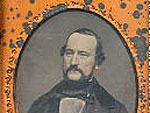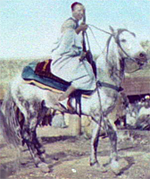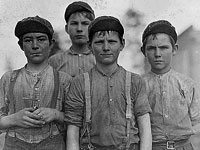The March on Washington
From the Library of Congress:
"The works of photographer Leonard Freed, specifically the photo essay "This Is the Day" about the 1963 March on Washington, is the subject of a lecture and discussion."
From the Library of Congress:
"The works of photographer Leonard Freed, specifically the photo essay "This Is the Day" about the 1963 March on Washington, is the subject of a lecture and discussion."

The Milwaukee Art Museum's collection includes more than 20,000 works of art ranging in date from antiquity to the present, and specializing in American decorative arts, German Expressionism, Haitian art, and American art after 1960. This website presents more than 200 pieces from the museum's collection. These works include paintings and sculptures, including several 20th-century works from Haiti; photographs, including Civil War-era portraits and masterpieces from the Great Depression era; prints and drawings primarily from French, Italian, German, and Flemish artists in the 17th-19th centuries; and a small collection of decorative arts, primarily furniture pieces from the early United States.
Beyond the website's Collection section, more artwork is on display in the Exhibitions section, which includes a selection of images from more than 25 current and past exhibitions. A highlight is the exhibit dedicated to the groundbreaking work of Milwaukee industrial designer Brooks Stevens. Here, visitors can view detailed images of some of his most famous designs, which include the Miller Brewing Company logo, the Evinrude outboard motor, and the Oscar Meyer Weinermobile.

This photograph archive contains more than 900 images made by American photographer William Henry Jackson (18431942) during his tour of North Africa, Asia, Russia, Australia, and Oceania from 1894 to 1896. The World's Transportation Commission, an organization formed to aid American business interests abroad, commissioned Jackson for this trip.
The photographs, originally exhibited in Chicago's Field Columbian Museum, focus on transportation systems, especially railroads, as well as tourist sites, indigenous life, wildlife, and locations of natural beauty. Nearly 687 of the images are from lantern slides, many of which were hand-colored. Many of the photographs appeared in Harper's Weekly. This collection is valuable for those interested in late 19th-century photography, colonialism, and industrialization.

ARC offers more than 78,000 digital government resources. Materials include textual records, photographs, maps, architectural drawings, artifacts, sound recordings, and motion pictures dating from the colonial period to the recent past. ARC includes items on presidents, the military, war, immigration, Japanese-American internment, slavery, science, prisons, federal programs, the environment, the National Park Service, foreign affairs, civil rights, African Americans, and American Indians.
To begin a search, click on the yellow "search" button near the top left of the ARC webpage. The search engine is clearly organized and invites queries on specific historical materials or general themes. To access digitized materials only, check the box marked "Descriptions of Archival Materials linked to digital copies." The site continues to expand, though, as it stands, it provides an exceptional collection of government material.

WhatWasThere.com is a free, dynamic site that allows historians of all ages to take a walk down memory lane as they pore over photos of the past. Created in Ann Arbor, MI, by Enlighten Ventures L.L.C., WhatWasThere lets users upload photos and place them at addresses found on Google Maps. Enlighten Ventures’ vision is to provide a photographic history of the world for users to investigate. Simply type in the name of a state, city, or local address and begin examining photos in the collection.
If you are ready to see the past, simply go to WhatWasThere.com and type in the name of the city, state, or country you are interested in exploring. Once at a specific location, the number of pictures available at a location is identified by map markers. Click on the marker and your time travel will commence. Zoom in or out of the map with the toggle bar located along the right-hand side of the screen. Look to the left to find thumbnails of the photographs available to study. Click on a photo, and you are taken to its exact location on the map. There, the photo detail tab allows you to learn the date the picture was taken and its title and read a detailed historical description. Roll over the photo with your mouse for a closer look. Another option is to click on the street view tab to see what your destination looks like today. The past will literally fade into the present as you adjust the sliding bar at the top of the photo. Again, you decide how much you want to see as additional photos found in the surrounding area are marked for further exploration. Using the photo markers provided, you can journey through the past of any area you have chosen.
While at WhatWasThere.com you can make history when you upload your own pictures or look at the latest photos that have been added to the website. If you have photos to share to help record your local history, become a member of the site to gain permission to post pictures. To set up a free account, just register a username, provide an email address, select a password, and begin uploading photos. "Tag" your photos with the year, location, descriptive information, your source, and the photo’s copyright status. If you know the street address of your image, you can position it on the Google street view, placing it directly over the address as it appears today. WhatWasThere is developing tools to let others who know your city help with the identification process if you are unsure of a photo's particular details. At this time, photos without specific addresses are not shared with other users.
Downloading the iPhone App for your iPhone or iTouch also allows you to access WhatWasThere.com mobilely, using the camera on your phone to view “an augmented reality experience of the history that surrounds you.” Consider friending WhatWasThere.com on Facebook to check out their version of “Today in History,” which daily features a photo from the site you can share with your students.
The most exciting aspects of WhatWasThere.com are its applications for use with students of all ages. Typically children view history through their modern lenses and not in the context in which events occurred. This site allows users to practice evidence-based thinking as they synthesize the evidence from historical photos with the information obtained from other sources. This will help students to begin thinking like a historian as they determine the impact of events that are recorded in history.
One example would be to use the site while learning about the Constitution. WhatWasThere will take your students on a virtual fieldtrip to Independence Hall. Once there, sharpen your social scientist skills as you compare and contrast photos from the early 1900s with those of the present. Class discussions can focus on the significance of this landmark, preservation issues, and any questions your students would like to investigate to help them learn more about the time period when the Constitution was written.
After students formulate questions, WhatWasThere.com is an excellent website for students to explore to help them understand “how we know what we know about the past.” WhatWasThere.com can encourage historical thinking as students “feel the history of a specific location in a new way.” Being exposed to America’s photographic history enables children to see the complexity of history from more than one point of view or perspective.
WhatWasThere not meeting your needs? Try Historypin, another online tool that organizes photos by time and place.
With the advent of the internet, you can find thousands of historic photographs with a few mouse clicks. Ask a Digital Historian has tips on where to start looking.
Visual primary sources are natural fits for students with developing English language skills. Get ideas for using photographs with English Language Learners in Teaching English Language Learners.
Your students will get the most out of visual sources if they source them—that is, if they ask where they came from. Learn a strategy for getting early elementary students excited about sourcing in Ask a Master Teacher.

Furnishes 64 photographs taken by Lewis W. Hine (18741940) between 1908 and 1912. Images document American children working in mills, mines, streets, and factories, and as "newsies," seafood workers, fruit pickers, and salesmen. The website also includes photographs of immigrant families and children's "pastimes and vices."
Original captions by Hine—one of the most influential photographers in American history—call attention to exploitative and unhealthy conditions for laboring children. A background essay introduces Hine and the history of child labor in the United States. This is a valuable collection for studying documentary photography, urban history, labor history, and the social history of the Progressive era.
Wes Cowan of PBS's History Detectives learns about the role of aerial reconnaissance and aerial photography in the Cuban Missile Crisis.
Tukufu Zuberi of PBS's History Detectives provides a brief overview of the history of aerial photography, particularly its use in reconnaissance.
Wes Cowan of PBS's History Detectives discusses the work of photographers during the Civil War, including how photographers manipulated reality in constructing their shots.
"John Muir was many things, inventor, immigrant, botanist, glaciologist, writer, co-founder of the Sierra Club, fruit rancher. But it was John Muir's love of nature, and the preservation of it, that we can thank him for today." The John Muir National Historic Site takes visitors on a tour of John Muir's Life, from his powerful nature photography to his roles as a writer and preservationist. In addition, visitors can admire Muir's beautiful home and learn more about the Muir family.
The site offers basic historical and visitor information about the National Historic Site, but links to Museum Collections at the John Muir National Historic Site website, located at http://www.nps.gov/museum/exhibits/jomu/index.html. This site contains more detailed historical and bibliographical information of John Muir, as well as photo galleries of all current exhibits. In order to contact the National Historic Site by email, use the "contact us" link on the original webpage.